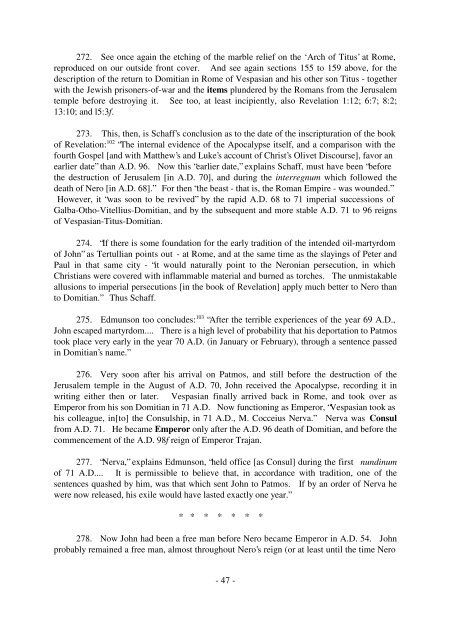JERUSALEM; ROME; REVELATION - The Preterist Archive
JERUSALEM; ROME; REVELATION - The Preterist Archive
JERUSALEM; ROME; REVELATION - The Preterist Archive
You also want an ePaper? Increase the reach of your titles
YUMPU automatically turns print PDFs into web optimized ePapers that Google loves.
272. See once again the etching of the marble relief on the ‘Arch of Titus’ at Rome,<br />
reproduced on our outside front cover. And see again sections 155 to 159 above, for the<br />
description of the return to Domitian in Rome of Vespasian and his other son Titus - together<br />
with the Jewish prisoners-of-war and the items plundered by the Romans from the Jerusalem<br />
temple before destroying it. See too, at least incipiently, also Revelation 1:12; 6:7; 8:2;<br />
13:10; and l5:3f.<br />
273. This, then, is Schaff’s conclusion as to the date of the inscripturation of the book<br />
of Revelation: 102 “<strong>The</strong> internal evidence of the Apocalypse itself, and a comparison with the<br />
fourth Gospel [and with Matthew’s and Luke’s account of Christ’s Olivet Discourse], favor an<br />
earlier date” than A.D. 96. Now this “earlier date,” explains Schaff, must have been “before<br />
the destruction of Jerusalem [in A.D. 70], and during the interregnum which followed the<br />
death of Nero [in A.D. 68].” For then “the beast - that is, the Roman Empire - was wounded.”<br />
However, it “was soon to be revived” by the rapid A.D. 68 to 71 imperial successions of<br />
Galba-Otho-Vitellius-Domitian, and by the subsequent and more stable A.D. 71 to 96 reigns<br />
of Vespasian-Titus-Domitian.<br />
274. “If there is some foundation for the early tradition of the intended oil-martyrdom<br />
of John” as Tertullian points out - at Rome, and at the same time as the slayings of Peter and<br />
Paul in that same city - “it would naturally point to the Neronian persecution, in which<br />
Christians were covered with inflammable material and burned as torches. <strong>The</strong> unmistakable<br />
allusions to imperial persecutions [in the book of Revelation] apply much better to Nero than<br />
to Domitian.” Thus Schaff.<br />
275. Edmunson too concludes: 103 “After the terrible experiences of the year 69 A.D.,<br />
John escaped martyrdom.... <strong>The</strong>re is a high level of probability that his deportation to Patmos<br />
took place very early in the year 70 A.D. (in January or February), through a sentence passed<br />
in Domitian’s name.”<br />
276. Very soon after his arrival on Patmos, and still before the destruction of the<br />
Jerusalem temple in the August of A.D. 70, John received the Apocalypse, recording it in<br />
writing either then or later. Vespasian finally arrived back in Rome, and took over as<br />
Emperor from his son Domitian in 71 A.D. Now functioning as Emperor, “Vespasian took as<br />
his colleague, in[to] the Consulship, in 71 A.D., M. Cocceius Nerva.” Nerva was Consul<br />
from A.D. 71. He became Emperor only after the A.D. 96 death of Domitian, and before the<br />
commencement of the A.D. 98f reign of Emperor Trajan.<br />
277. “Nerva,” explains Edmunson, “held office [as Consul] during the first nundinum<br />
of 71 A.D.... It is permissible to believe that, in accordance with tradition, one of the<br />
sentences quashed by him, was that which sent John to Patmos. If by an order of Nerva he<br />
were now released, his exile would have lasted exactly one year.”<br />
* * * * * * *<br />
278. Now John had been a free man before Nero became Emperor in A.D. 54. John<br />
probably remained a free man, almost throughout Nero’s reign (or at least until the time Nero<br />
- 47 -
















